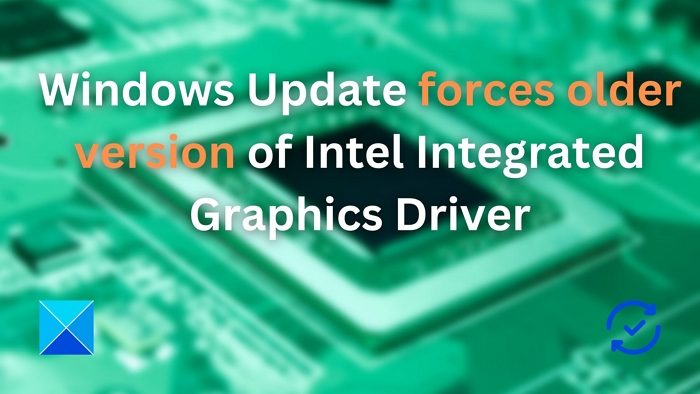Windows keeps installing old Intel Graphics Driver
It might be frustrating when Windows Update forces installing an earlier version of the Intel Integrated Graphics driver. Here are a few solutions to the problem. Make sure to use an administrator account to execute these suggestions.
1] Uninstall the older version of the Intel driver
Uninstalling the previous version from your computer is one of the initial solutions to try. While most updates replace an existing version, some may be installed as a new entity. Here’s how to uninstall an older version of the Intel Graphics Driver using the Device Manager.
Right-click on the Windows Start menu and click on the Device Manager option.Here, locate and expand the section for Display Adaptors.Under the Display Adaptors subsection, select the Integrated Graphics adapter and right-click on Uninstall Device.Select Delete the driver software for this device optionRestart PC.
Once done, go back to the device manager, and check that the Graphic controller in the device manager is now listed as Microsoft Basic Display Adapter, Standard VGA Graphics Adapter. If you still notice Intel, you need to repeat the steps and remove them. Finally, you will need to uninstall any Intel-related applications on your PC. Sometimes, these applications can automatically update the driver you don’t want. We can set it once we have disabled the driver updates from Windows Update. Here is another situation that some users may face. Some OEMs bundle drivers in such a way that it becomes impossible to remove the drivers. At times even OEMs are at fault for installing older versions. The only way out is to download the Driver updater application offered and then uninstall or contact them to find out what can be done to get rid of the old drivers. Here is the list of OEMs listed on Intel’s official page to get this sorted.
2] Disable Driver Updates via Windows Update
You can also prevent Windows from searching for new driver updates. Still, any future upgrades will require you to manually download them from the manufacturer’s website or a third-party program.
Follow these steps to disable Automatic Driver updates in Windows using the Group Policy Editor:
Begin by pressing the Windows + R on the keyboard to open the Run window. Then, type gpedit. msc, press Enter, or click OK to launch the Local Group Policy Editor.Go to the following path under the Group Policy Editor:
Open the Manage updates offered from the Windows Update folder.Find and double-click on the policy stating Do not include drivers with Windows Updates.Set the toggle to Enabled in the new dialogue box that appears, then click Apply, then OK.
Restart your computer for the modifications to take effect. You may also enable Windows Updates to look for driver updates by returning the setting to Not Configured or Disabled. Read: Windows keeps offering or installing the same Update
3] Disable Driver updates via Registry Editor changes
The registry is a database that maintains operating system and software configuration information and options. When using the Registry Editor, use caution because making changes to the registry can have unforeseen implications and potentially cause problems with your computer. It is advised to avoid using the Registry Editor if you are unfamiliar with the registry or are not comfortable making changes to it. To prevent automatic driver updates via Windows Update, follow these steps:
In the Start Search Box, key in Run and choose the main listed result to open the Run Dialog.In the text box, key in regedit and press Enter on the keyboard to launch the Registry Editor.Now, use the left navigation pane to navigate to the following path:
Look for the DriverSearching folder or Key. If it’s not there, then right-click on the Windows Key, choose New > Key, and name the key as DriverSearching.Go inside the DriverSearching key, and you should find a DriverUpdateWizardWuSearchEnabled; double tap on it and set its value to 0.If you don’t find the DriverUpdateWizardWuSearchEnabled key, under the DriverSearching folder, right-click and choose New DWORD (32-bit) and name it DriverUpdateWizardWuSearchEnabled, and set the value to 0.Close the Registry Editor and restart your computer for changes to come into effect.
Once you have applied the changes, going further, you will need to download the most recent drivers from the OEM and install them on your computer. Intel offers a driver update solution of its own, which you can download and install the updates as they arrive. Conclusion It is essential to keep your drivers up to date to ensure that your devices are functioning correctly and to benefit from any performance improvements or bug fixes included in newer versions of the drivers. However, Windows Update may occasionally force installing an earlier version of a driver, which can cause issues with your system. We hope this post was able to help you fix the problem.
How do I update Intel integrated graphics drivers?
Once you have disabled the driver updates via Windows, here is how you can manually update Intel graphics drivers:
Go to the official intel.com website, search, locate and download the driver.Once you find it, download the EXE file on your PCDouble-click to launch it, and during the installation process, when you reach the Install stage, click the Customize buttonMake sure not to enable the Execute a clean installation check box.After finishing the driver installation, click the Optional reboot button.
Read: Windows keeps installing old AMD drivers
How do I uninstall a driver update on Windows?
You can uninstall the driver update using multiple ways. The list includes Device Manager, Installed Apps in Windows, Control Panel, and using the DISM command. The last one offers the Get-Drivers feature, which can delete the driver based on the Published Name. Lastly, you can also use a third-party uninstaller to achieve this.

